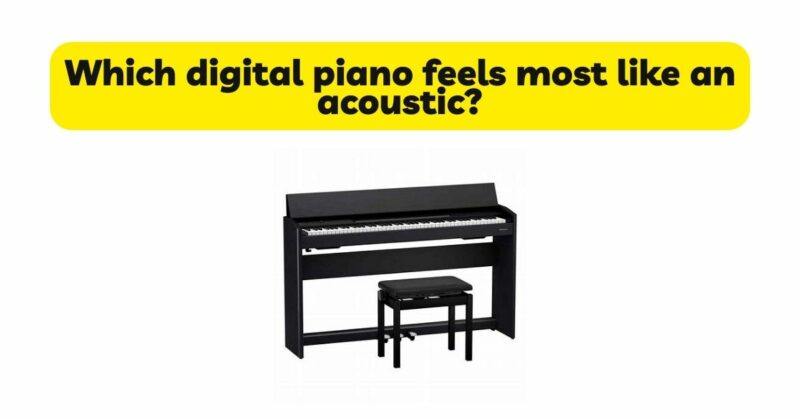For pianists who seek the authentic touch and feel of an acoustic piano combined with the convenience and versatility of a digital instrument, finding a digital piano that closely replicates the tactile experience becomes crucial. While digital pianos offer numerous advantages such as portability, recording capabilities, and a variety of sounds, they vary in their ability to capture the authentic touch and response of an acoustic piano. In this article, we delve into the key factors that contribute to a digital piano feeling like an acoustic piano, including key action, key weight, key material, key shape, and touch sensitivity. By examining these elements, we aim to provide insights into digital pianos that strive to emulate the feel of an acoustic piano, helping pianists make informed decisions based on their preferences, playing style, and musical aspirations.
- Key Action: Key action is a fundamental element in replicating the feel of an acoustic piano on a digital instrument. Acoustic pianos utilize a complex mechanism where the keys are connected to hammers that strike the strings. Digital pianos aim to mimic this mechanism by incorporating various types of key actions. The best digital pianos employ high-quality key actions such as fully weighted, graded hammer action, or wooden-key actions. These key actions simulate the weight, response, and tactile feedback of acoustic piano keys, providing a more authentic and immersive playing experience.
- Key Weight: The weight of the keys plays a significant role in emulating the feel of an acoustic piano on a digital instrument. Acoustic piano keys have a specific weight that varies throughout the keyboard, with the lower register being heavier and the higher register becoming lighter. Digital pianos strive to replicate this weight distribution by incorporating weighted or graded hammer action keys. Weighted keys provide resistance and a sense of touch that closely resembles playing on an acoustic piano. Graded hammer action keys further enhance the piano-like feel by mimicking the gradual increase in key weight as you move from the lower to the higher register.
- Key Material and Texture: The material and texture of the keys contribute to the tactile experience and authenticity of a piano-like feel. Acoustic piano keys traditionally use materials such as wood, which can provide a warm and natural touch. Some digital pianos aim to mimic this material with synthetic alternatives that replicate the feel and texture of real piano keys. For example, synthetic ivory or ebony surfaces can enhance the tactile response and provide a more authentic playing experience. Paying attention to the key material and texture can help in selecting a digital piano that closely resembles the touch and feel of an acoustic piano.
- Key Shape and Size: The shape and size of the keys play a role in replicating the piano-like feel on a digital instrument. Acoustic pianos have specific key dimensions and shape that are comfortable for most players. Digital pianos aim to mirror these dimensions to provide a familiar and natural playing experience. Keys that closely match the size and shape of traditional piano keys can enhance the piano-like feel and facilitate seamless transitioning between a digital piano and an acoustic piano. Pianists should consider the key shape and size that aligns with their hand size and playing technique to ensure a comfortable and authentic experience.
- Touch Sensitivity: Touch sensitivity is a crucial element in replicating the feel of an acoustic piano on a digital instrument. Acoustic pianos respond to the varying degrees of pressure applied to the keys, resulting in variations in volume and tone. Digital pianos strive to replicate this touch sensitivity through velocity-sensitive keys. Velocity sensitivity allows the digital piano to detect and respond to the force or speed at which each key is pressed, resulting in variations in volume and tone, just like an acoustic piano. The presence of touch sensitivity enhances the expressiveness and dynamic control, closely resembling the responsiveness of an acoustic piano.
- Additional Features: While replicating the feel of an acoustic piano is essential, digital pianos offer additional features that can enhance the overall playing experience. Consider features such as adjustable key response, which allows customization of the keyboard’s touch sensitivity to suit individual preferences. Some digital pianos also offer adjustable key resistance, allowing pianists to adapt the keyboard’s feel to their desired playing style. Exploring the range of sounds and piano voices available on the digital piano, as well as considering features like recording capabilities, connectivity options, and compatibility with external devices, can further expand the creative possibilities and versatility of the instrument.
Conclusion: While no digital piano can fully replicate the intricate mechanisms and nuances of playing an acoustic piano, several digital pianos come remarkably close to emulating the feel of an acoustic piano. By considering key factors such as key action, key weight, key material, key shape, touch sensitivity, and additional features, pianists can identify digital pianos that provide a more authentic and immersive playing experience. The choice between a digital piano and an acoustic piano ultimately depends on individual preferences, musical requirements, and the desired balance between authenticity and versatility. By selecting a digital piano that closely emulates the feel of an acoustic piano, pianists can enjoy the convenience, flexibility, and expressiveness of a digital instrument while experiencing a piano-like touch and response.


